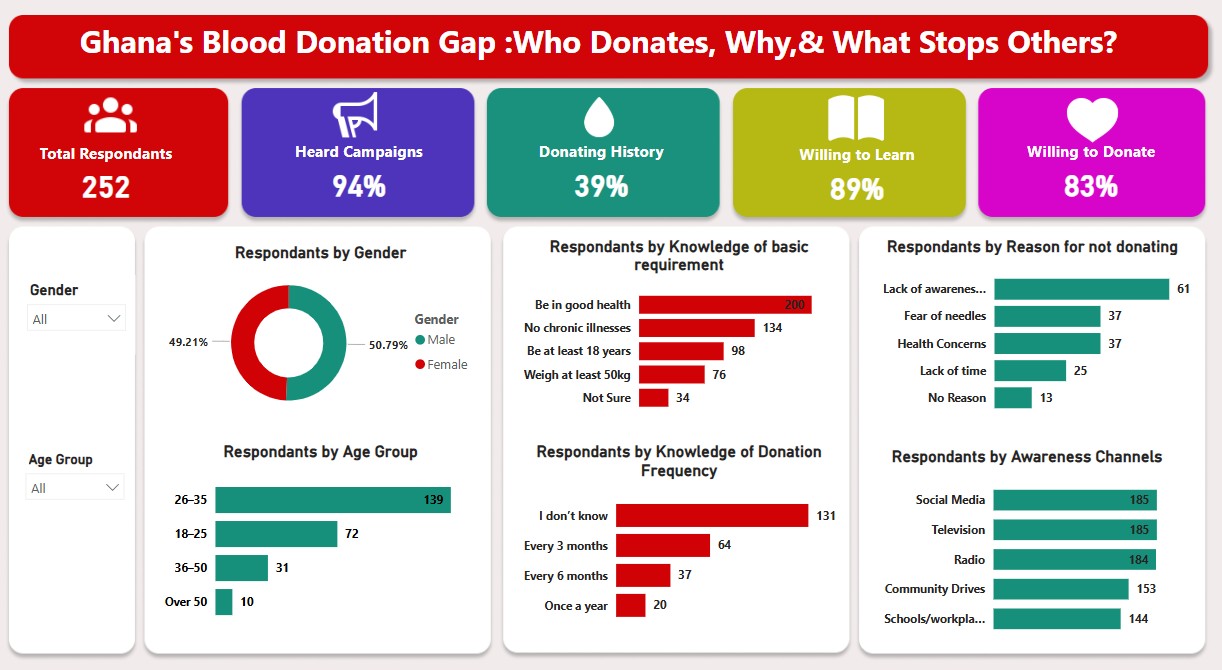What’s stopping Ghanaians from donating blood?

As a data analyst and biomedical scientist passionate about blood donation, transfusion, and management, I set out to find answers. I surveyed 252 individuals across different age groups and genders to uncover the awareness levels, motivations, and barriers behind Ghana’s low voluntary blood donation rates. The goal? To spark better outreach, shape policy, and drive meaningful change.
What emerged was a powerful story of potential. The data reveals that while actual blood donation remains low, the willingness to donate is overwhelmingly high. This disconnect between intention and action holds the key to transforming Ghana’s blood donation culture.
Key Findings: Willing Hearts, Missing Bridges

From the survey:
- 39% of respondents have donated blood before.
- 83% are willing to donate.
- 89% are eager to learn more.
- 94% have been exposed to blood donation campaigns.
These are encouraging numbers. They tell us that people are not opposed to donating blood—they just need clearer paths, fewer fears, and more information.
The Demographic Edge: Young People Are Our Hope


- The majority of respondents (55%) were aged between 26–35, followed by those 18–25 (29%).
- Gender distribution was nearly equal: 50.79% male, 49.21% female.
This shows that Ghana’s young adults, who are often the most active and mobile, are also the most reachable. They represent an untapped reservoir of life-saving potential.
Gaps in Knowledge


When asked about donation eligibility, knowledge was fragmented:
- Only 76 knew about the minimum weight requirement (50kg).
- 98 knew you must be at least 18 years old.
- 34 people weren’t sure of any requirements.
On donation frequency, over 50% (131 people) said they didn’t know how often one could safely donate. These knowledge gaps don’t just cost pints—they cost lives.
Barriers to Donation: Myths, Fears


Even among those willing to donate, key barriers persist:
- 61 people cited a lack of awareness.
- 37 feared needles.
- Another 37 had health concerns.
- 25 said they lacked time.
- 13 offered no reason at all.
Channels of Awareness: Media Is Doing the Heavy Lifting
- Social media and television were each cited by 185 respondents as major sources of information.
- Radio (184), community drives (153), and schools/workplaces (144) followed closely.
The data makes it clear: media matters. But so does how the message is delivered—credibility, relatability, and consistency are key.
What the WHO Says: Why This Matters on a Global Scale
According to the World Health Organization, blood donations are still not sufficient in many low- and middle-income countries. Here’s the big picture:
- Only 62 countries collect 100% of their blood supply from voluntary, unpaid donors—a gold standard that ensures safety, availability, and sustainability.
- In contrast, 40 countries still rely on family or paid donors, posing risks to both donor and recipient health.
- Low-income countries collect only 16 donations per 1,000 people, compared to 33 donations per 1,000 in high-income nations.
Ghana falls into the lower donation rate bracket. Yet, as this survey shows, we have the will—we just need the system.
What Can Ghana Learn from the UK?
Countries like the United Kingdom have built robust, reliable blood donation systems led by organizations like NHS Blood and Transplant. In the UK:
- Blood donation is a national norm, not an emergency act.
- Voluntary, non-remunerated donation is the gold standard.
- Digital reminders, personalized thank-you(s), mobile clinics, and public recognition keep engagement high.
- Education starts early—in schools—and continues through workplace campaigns and community outreach.
Ghana can adapt these strategies, embedding a culture of giving through youth engagement, trusted education, and public recognition of donors.
Where Do We Go From Here?
1. Simplify the message.
The basic requirements to donate blood must be communicated clearly and repeatedly through media, schools, and local leaders.
2. Make donation accessible.
Bring mobile blood drives to workplaces, universities, churches, and events. Don’t wait for people to come—go to them.
3. Build trust.
Many people fear the unknown. Share donor stories, show the donation process, and answer FAQs publicly.
4. Celebrate the givers.
Recognition doesn’t have to be grand—a thank-you message, a donor badge, or a social media shout-out goes a long way.
5. Start with the youth.
Young people are curious, willing, and ready to lead. Equip them with knowledge, involve them in campaigns, and empower them as blood donation ambassadors.
Conclusion: The Time for Action Is Now
This survey confirms what many health professionals already suspect: the issue isn’t a lack of willingness—it’s a lack of structure. If 83% of people are ready to give blood, then the problem isn’t the people—it’s the system. We need a national movement, backed by policy, powered by data, and driven by empathy. Every pint of blood can save up to three lives. Imagine what Ghana could become if we built a system that turned every willing citizen into a regular donor. Let’s build it—one campaign, one conversation, one donation at a time.
